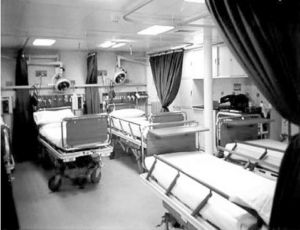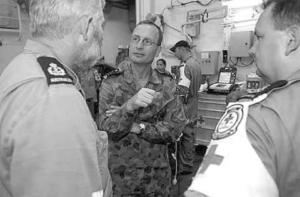Health support is an important consideration in any joint or combined operation. From a practical perspective, health support, both preventative and
therapeutic, exists to conserve the fighting strength of the forces, ultimately contributing to the maintenance of operational capability and the success of the mission. Health support is also influenced by Australian societal expectations that injured members of the armed forces will have access to competent medical care from the time of injury until completion of the rehabilitation process.
The level of health support to any Australian Defence Force (ADF) activity is based on a hierarchical system of casualty management (from Level One to Five)1 that may be affected by numerous factors, including the nature of the activity itself, weapon systems and other technologies, medical and physical fitness of the force, emerging disease patterns, the availability of other ADF health services and evacuation assets, and the extent and availability of civilian health infrastructure. It is a principle of health support that no patient should be evacuated further than their physical condition requires, and the provision of health support facilities as far forward as tactically possible helps to ensure that the treatment and evacuation process remains continuous and rapid.
An established Primary Casualty Reception Facility(PCRF) comprising a Level Three2 health capability deployed in a ship, enables the early
treatment of casualties afloat. A PCRF is only activated in anticipation of casualties and allows a ‘window of opportunity’ to effectively treat an injured member prior to the establishment and securing of health provision ashore. Operational planning may incorporate a reduction in levels of health logistic support ashore where an Afloat Level Three Medical Facility (AMF) is in the Area of Operations (AO). Importantly, the presence of such a well-equipped and safe AMF in the AO also assists in the maintenance of troop and crew morale.
The capacity to make available surgery and postoperative support in the AO also limits the requirement for dedicated platforms and personnel to
perform strategic aeromedical evacuation (AME).3 Recent experience in Iraq (Operations IRAQI FREEDOM and ENDURING FREEDOM) has shown
that the majority of wounded soldiers can be medically evacuated to definitive care, using helicopters for forward AME, within half an hour of initial injury.4
In December 1993, the Australian Government approved the purchase of two United States Navy Newport class Landing Ships Tank, which were
commissioned as HMA Ships Kanimbla and Manoora. The ships underwent extensive conversion to meet the requirement for a joint amphibious capability, including the fitting of dedicated communications and operations facilities to support tactical commanders, a hangar and flight decks capable of supporting up to four Army Black Hawk or three Navy Sea King helicopters, and two Army landing craft. Now classified as amphibious transports (LPA), the primary military role of each LPA is to transport, lodge ashore and support an Army contingent of 450 troops, their vehicles and equipment. In addition, they also contribute to a range of constabulary and diplomatic tasks, including peacekeeping operations, the protection and evacuation of Australian nationals within the region in the event of serious civil disturbance, andsupport to disaster relief operations both within Australia and the region.5
A fully equipped PCRF is an intrinsic capability in both vessels, incorporated in response to an anticipated increase in the need for the ADF to participate in a broad range of national and international tasks and to provide medical support for them. The PCRFs aboard Kanimbla and Manoora consist of a Casualty Reception Area located forward of the hangar; a modern Operating Theatre; an eight-bed High Dependency Unit, with two
of those beds able to be utilised as Intensive Care beds; a 36 bed Low Dependency Unit and X-ray and pathology equipment; while dental services can be provided when required. Casualties are usually accepted by helicopter, but sea transfer can also be used if necessary.
Staffing is determined using a modular capability system. Medical capability elements that can be deployed include AME, resuscitation, primary health, intensive care, operating theatre, and command teams. Depending on the level of activation, up to 67 personnel will join the LPA, reducing troop carrying capacity by the same number.
The PCRF, although located adjacent to the ship’s sickbay, are considered a separate entity, so the ship’s senior Medical sailor manages the routine medical care of the ship’s company. To prevent deterioration of costly medical equipment and unit infrastructure when not activated, the facilities are each permanently staffed with a RAN Nursing Officer responsible for sourcing and maintaining the equipment and medical stores. This ensures that the facilities are ready for rapid activation when required.

PCRF in HMAS Kanimbla (RAN)
A shore-based Operations Cell, which reports formally through the Amphibious and Afloat Support Force Element Group (AASG), supports the Nursing Officer. Logistic support for the PCRFs, when activated, is significant, and the vital components of a functioning medical facility are all provided, including waste disposal, laundry requirements, medical gases, drugs, and cleaning and sterilising agents. The PCRF maintains
sufficient consumable stores at all times to provide care to a significant number of personnel for approximately five days. This provides adequate lead-time to re-supply should the activation be extended or conflict escalate, and for other appropriate contingency measures to be put in place.

Commander Maritime Task Group talks with PCRF medical Personnel during Operation SUMATRA ASSIST (Defence)
Balmoral Naval Hospital (BNH) provides the majority of personnel to fill PCRF billets when the facility is activated.The staff complement of the PCRFs is also augmented from time to time by active tri-Service specialists, usually orthopaedic or general surgery specialists and anaesthetists. In circumstances where only one PCRF has been activated, the Medical Officer in Charge (OIC) of BNH assumes the role of OIC PCRF for the duration of the operation wherever possible. As a relatively new RAN capability, all aspects of the PCRF have matured and been further developed through operational experience. The PCRF Operations Cell was established formally in 2003 and provides dedicated personnel to examine logistic and personnel aspects of the units as their primary role, and to action recommendations from post-exercise/deployment reports. This cell moved from BNH under the OIC BNH to the AASG under the Capability Delivery section in October 2005.
Early lessons learned invariably focused on equipment, logistic supply of consumable items and a lack of allocated space to perform casualty triage. No medical equipment on board was specifically marinised and certain adaptations have been required to ensure safety of the equipment in a moving environment. Various methods of logistic supply have been investigated as management of medical consumables, often with a short shelf life, absorb considerable time and are better handled by personnel with medical knowledge. Ship’s Operating Procedures were required to detail the dual functionality of the hangar space to ensure both medical and aviation requirements could be met.
The LPAs have substantially boosted RAN amphibious, logistic and training capabilities and provided the first deployable Level Three medical
capabilities since the decommissioning of the aircraft carrier HMAS Melbourne in 1982. The PCRFs have contributed significantly to the ability of the ADF to respond to national and regional commitments either independently, or as an element of combined operations. From the first activation during Operation GOLD for the 2000 Olympics, the PCRF has been utilised in numerous major deployments since, including for combat operations in Iraq and Afghanistan (Operations CATALYST and SLIPPER), in peacekeeping operations in the Solomon Islands (Operations ANODE and
TREK), in border protection (Operation RELEX) and, most visibly, in humanitarian assistance in the wake of the Indonesian tsunamis and earthquakes in early 2005 (Operations SUMATRA ASSIST I/II). Foreign nationals have been treated on board on two occasions (Operations
RELEX and SUMATRA ASSIST I/II).6 Most patients, however, have been ADF personnel who have been treated, stabilised and medically evacuated to definitive care ashore, or returned to duty.
The utility of the PCRF and its proven efficacy in boosting medical capability in various operational environments, demonstrated once more during the recent deployment of Kanimbla to East Timor for Operation ASTUTE,7 has led to a similar requirement being identified in the planned acquisition of the two new RAN amphibious ships (LHDs) from 2012.
1. ADF Publication 53, Health Support, Defence Publishing Service, Canberra, 1998, pp. 1-1 & 1-2.
2. A Level Three facility is staffed and equipped to provide resuscitation, initial surgery and postoperative treatment. Care at this level may be the
initial step towards restoration of functional health as distinct from procedures that stabilise a condition or prolong life; ADFP 53, Health Support, p. 1-1.
3. Strategic AME is that phase of evacuation that provides airlift for patients out of the AO; ADFP 53, Health Support, Glossary.
4. Forward AME is that phase of evacuation that provides airlift for casualties, from the battlefield to the initial point of treatment within the AO; ADFP 53, Health Support, Glossary.
5. Royal Australian Navy, The Navy Contribution toAustralian Maritime Operations, Defence Publishing Service, Canberra, 2005, pp. 104-8.
6. Royal Australian Navy, Database of Royal Australian Navy Operations, 1990-2005, Working Paper No. 18, Sea Power Centre – Australia, Canberra, 2005; and ‘Operation Sumatra Assist Two’, Goorangai, Occasional Papers of the Royal Australian Naval Reserve Professional Studies Program, Volume 2, Number 1, April 2006.
7. Royal Australian Navy, ‘Operation Astute – the RAN in East Timor’.






